The most pervasive water pollution source in American cities and suburbs is the contaminant-laced rainwater that sloughs off hard surfaces like streets and parking lots after a heavy rain, carrying with it the toxic debris of modern life.
 This little-noticed form of pollution kills fish and other aquatic creatures, pollutes drinking-water supplies and scours away streambeds that fish such as salmon need to lay eggs. At least since the 1970s, scientists and engineers have been devising methods to intercept –- or better yet, never generate –- this so-called stormwater.
This little-noticed form of pollution kills fish and other aquatic creatures, pollutes drinking-water supplies and scours away streambeds that fish such as salmon need to lay eggs. At least since the 1970s, scientists and engineers have been devising methods to intercept –- or better yet, never generate –- this so-called stormwater.
Yet these methods still are not widely mandated, making stormwater one of the leading reasons the Clean Water Act –- passed into law 40 years ago today -– has failed to meet its goal of making all American waterways fishable and swimmable.
Experts’ modern consensus: Handling stormwater is all about building our cities differently, with more greenery to slurp up the rainwater. Techniques to accomplish this include specially designed swales, green roofs, rain gardens and porous pavement that allows the water to soak into the ground instead of gurgling into a stream.
So why are these techniques – part of a new building approach commonly dubbed low-impact development or green stormwater infrastructure – not more widely required in the Pacific Northwest when a developer plunks down building plans at City Hall today?
The explanation differs according to the state:
- In Washington, these updated building techniques have been the subject of repeated legal battles. Cities say they are unprepared to handle the costs and need training for their building officials. Developers say they want more flexibility. The requirements currently are set to start becoming mandatory as of mid-2015, although those rules have been delayed several times in the past.
- In Oregon, where environmentalists have pushed for years to require better control of stormwater, legal changes start to take effect in large cities in 2014. A budget-battered state agency that currently has one person assigned to the task ultimately plans to audit individual building projects in more than 50 cities to see if the cities are making sure developers are complying with the Clean Water Act.
- In Idaho, far less urbanized than its sister states in the Northwest, the issue has been less intensively argued and studied. Boise has been taking steps to reduce stormwater pollution and is about to grapple with requiring the tweaked building methods, too, although it likely will be years before they are required elsewhere in the state.
Green infrastructure takes voluntary root
The low-impact building techniques have become increasingly common in the last decade or so and are routinely employed by some builders. That’s especially true where developers can save money because they don’t have to set aside land for pollution-cleaning ponds where the dirty water can be dumped until many pollutants can settle out of the water.
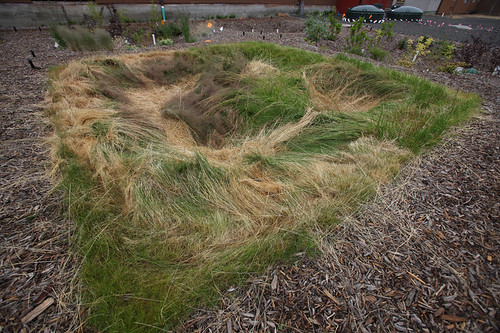
A native-grass rain garden being tested at the Washington Stormwater Center. Credit: Katie Campbell/EarthFix
Meanwhile, a handful of Northwest cities – notably Portland and Seattle and a few of their suburbs — have attempted to mandate some form of low-impact development. Others are increasingly considering whether the new building methods should be required.
However, developers in the Northwest largely are not yet legally required to follow these practices.
Environmentalists thought they were on the verge of victory in 2008 when they won a legal ruling in Washington saying low-impact development is required under the Clean Water Act in large cities. It was the first such judicial decision in the nation. A second ruling said smaller cities would have to follow suit soon.
Instead, legal wrangling continues four years later.
“Our clients have been advocating for this for some time now,” says Jan Hasselman, the Seattle attorney who won the ruling by the Washington Pollution Control Hearings Board on behalf of the Puget Soundkeeper Alliance and People for Puget Sound. “It’s disappointing this is moving so slowly because low-impact development isn’t that new or difficult or technical. Leave more vegetation in place and don’t pave over everything, and you’ve got a good start.”
Fighting mandates for low-impact development
Developers say the low-impact methods are promising, but shouldn’t be required because every building site is different.
“When you mandate it, some (developers) will tell their engineers: See if you can find a way to show this is impossible” at a given site, said Art Castle, Executive Vice President of the Building Industry Association of Washington. “If you encourage it, (developers) will tell their engineers: See if you can find a way to do this.”
Low-impact development aims to mimic the natural hydrology of the Northwest. Before development, rains were intercepted by the lush forests that dominated the landscape. The rain that was not caught by the canopy of conifers soaked into the ground and eventually seeped into streams, lakes and bays over a period of months to years.
Today, rain hitting hard surfaces instead flows quickly to the nearest waterway. It picks up contaminants, including oil, transmission fluid, fertilizers, and pesticides, as well as toxic metals such as copper from car brakes, a substance that can be lethal to salmon.
Pollution isn’t the only downside of stormwater. The speed and force of the runoff scours stream bottoms, which can jeopardize whole classes of aquatic insects crucial to the food chain. The problem was highlighted in a groundbreaking report by the National Academy of Sciences in 2008, which called stormwater “one of the great challenges of modern water pollution control.”
Scientists from the Northwest first calculated in the early 1990s that worrisome changes start to take place when just one-tenth of a watershed has been developed. It’s not uncommon for half to three-quarters of the ground in a city to be covered with hard surfaces where the water can’t soak into the ground.
“Stormwater is the No. 1 water pollution problem in Washington’s most populated areas,” said Ted Sturdevant, head of the Washington Department of Ecology. “How we lived on the land and developed the land – we’ve done that in ways that have polluted our waters.”
Here’s how the struggle to control stormwater through modern building methods is playing out across the Pacific Northwest:
Washington
Washington won’t require low-impact development until mid-2015, eight years after the ruling by the state’s Pollution Control Hearings Board – and then only for local governments serving more than 100,000 people. Smaller local governments must have codes in place requiring low-impact development by the end of 2016.
The push to clean up stormwater has been bolstered by a state campaign to restore Puget Sound, Washington’s much-loved inland sea, where studies show the biggest shots of toxic pollution are coming from stormwater.
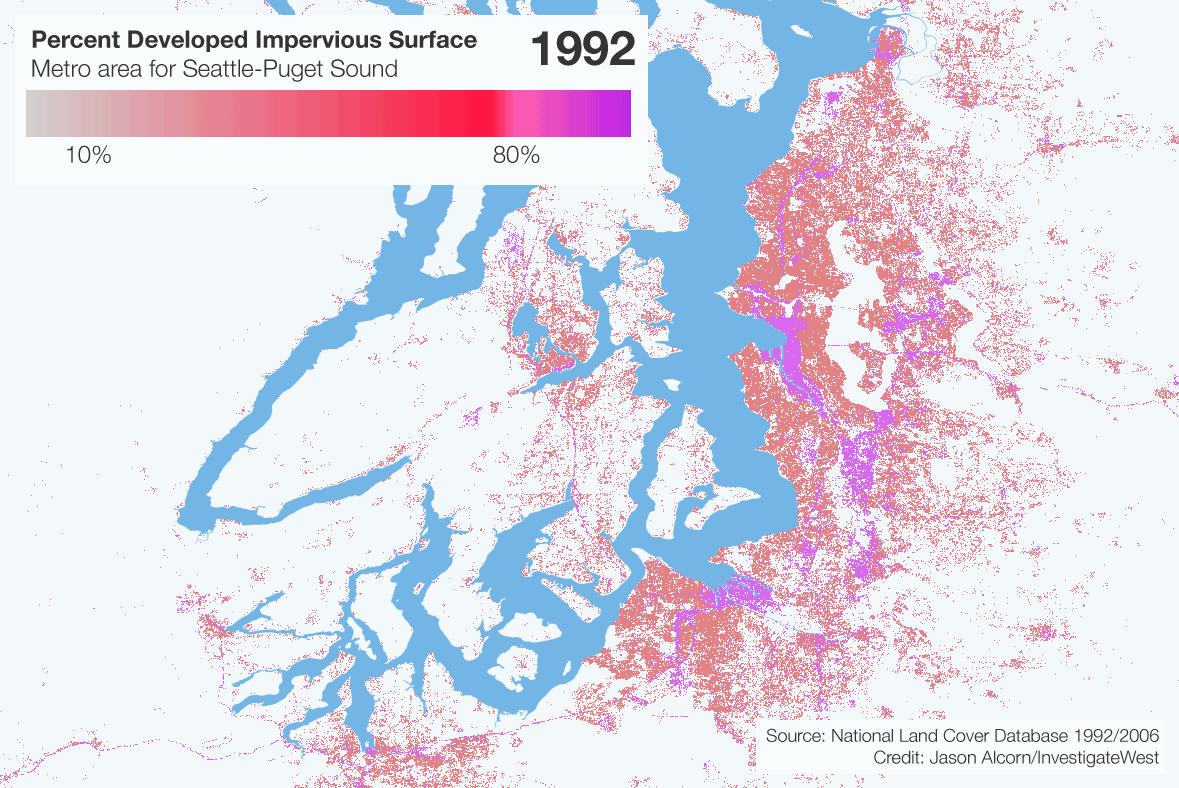
City officials say they are moving as fast as can be reasonably expected to tackle the problem. After environmentalists prevailed in the court action, builders’ groups and lobbyists for municipalities teamed up. They persuaded the Washington Legislature in 2011 and 2012 to delay the date by which the local governments must start requiring low-impact development. They cited strapped municipal budgets.
When the state Ecology Department proposed a new generation of stormwater rules in August to help comply with the legal ruling, it quickly attracted half a dozen legal challenges, mostly from local governments, but also one by a builders’ group, the Building Industry Association of Clark County.
One appeal came from the government of Pierce County, where more than one-third of waterways are polluted by stormwater. Pierce County argued:
“Without major funding assistance from the state and federal government, neither Pierce County nor any other local government could hope to achieve the State Legislature’s goal of achieving a healthy Puget Sound by addressing stormwater runoff.”
A coalition of more than a dozen medium-sized cities also is challenging the new rules, saying in court papers: “The Permit issued by Ecology replaces … necessary flexibility with highly prescriptive requirements. In many cases, Ecology imposed these requirements without considering their cost, feasibility or practicability…”
One of the cities joining the challenge was Issaquah, about a 20-minute ride east of Seattle. On a recent day, Issaquah Public Works Department engineer Kerry Ritland watched as a city crew used a long tube to suck up all the polluted gunk that had collected below a manhole in what’s known as a catch basin.
Cleaning out catch basins is an excellent way to de-pollute stormwater, Ritland says: “catch basin maintenance is very important and that’s what they’re designed to do is intercept those pollutants.”
Kerry Ritland. Credit: Ashley Ahearn
But here’s the problem:
“Well, Ritland said, “the city has upwards of 6,000 or more of these catch basins.”
For their part, developers argue that insisting on low-impact development for new building projects and redevelopment projects misses the bulk of the problem, which is caused by the way cities have traditionally been built for decades. To truly address the problem, they argue, older developments should be targeted, because they represent the bulk of the problem.
The Washington Department of Ecology, which has been repeatedly buffeted by lawsuits from both sides of the issue, says it has to start somewhere, and that is going to be with the building projects being done now where government has a say in how things are done.
“What we’re trying to do is stop the bleeding,” said Bill Moore, the agency’s lead stormwater strategist. “Then we’ll figure out how to address the historical legacy deficit.”
Another major objection from cities and developers is that there hasn’t been enough training for builders as well as the building officials at city hall on how low-impact development should work.
“Once you get beyond the superficial knowledge that, hey, low-impact development is a good thing, getting people up to speed on the technical issues is the way to be able to creatively apply LID,” said Castle, of the state building industry association.
This year the state Legislature appropriated $1 million for training, saying it plans to disburse $1 million a year for five years to get the job done.
Oregon
If the high-stakes statewide battle over low-impact development in Washington is to be repeated in Oregon, it seems likely to play out as a series of skirmishes at the local level as towns and cities adopt their own approaches to handling stormwater.
That’s because while Washington issues a few sets of rules covering large and medium-sized cities on both sides of the Cascades, the Oregon Department of Environmental Quality requires each local government or group of local governments to come up with its own law and procedures to handle stormwater.
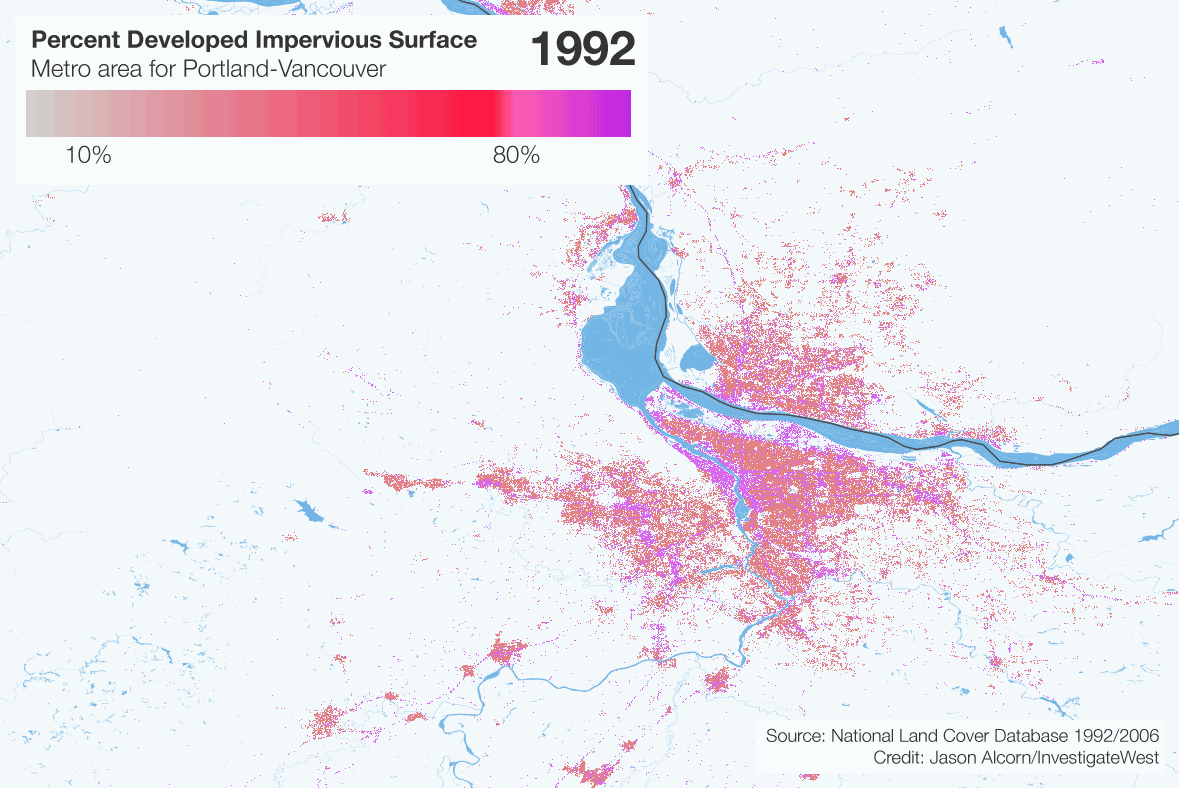
In 1994, the Oregon Department of Environmental Quality began issuing municipal stormwater permits – sets of rules and conditions – allowing large cities to operate systems to move stormwater off the land and into water bodies. Since then, stormwater technology has changed. It’s not just about a pipe sending stormwater to a river or stream. Stormwater management includes stopping the water from getting into storm drains in the first place.
After those permits were routinely updated in 2006, environmental groups sued the state, saying DEQ had, among other things, failed to require low-impact building methods, said Chris Winter, attorney for the Crag Law Center, which represented the Tualatin, Willamette and Columbia Riverkeeper groups.
Winter described DEQ’s attitude toward low-impact development at the time as “recalcitrant.” But in a new round of permits issued by DEQ in recent years, the agency is beginning to require some attention to low-impact development techniques.
The new stormwater permits include requirements to further reduce runoff. Typically this means trying to mimic what happened to water before development, trying to use low-impact development or similar techniques, and – importantly – capturing 80 percent of the average annual volume of rain falling on the site.
Cities also have to review their ordinances, codes and development standards and eliminate or minimize barriers to the newer building methods.
Portland already has been reviewing and updating its codes on a regular basis. For instance, the city upgraded its parking lot construction code to remove barriers to the newer building technologies in the 1990s, said Patrice Mango, the city’s stormwater program manager.
One of the first projects to take advantage of that was at the Oregon Museum of Science and Industry in southeast Portland. Runoff from more than four acres of its riverside parking lot drains into bioswales, which filter the runoff before it drains to the Willamette River. Before the bioswales were installed, more than 522,000 cubic feet of untreated stormwater runoff hit the river each year, according to the project’s final report.
The Portland City Council adopted a Green Streets policy in 2007, and it has an Ecoroof policy, which requires all new city-owned facilities and all municipal roof replacement projects to install vegetated roofs.
“We have done a lot, but you learn as you go along,” said Mango. “We take input from development reviewers and developers. So if you want to do a pilot project, we want to hear about it and see if we need to change our code.”
Portland will begin another citywide code review in 2013, Mango said.
Adjusting city codes to allow for low-impact development and educating city permit reviewers is an important first step in making sure the techniques can be used widely, environmentalists and developers agree.
Like Portland, Salem is preparing to review its codes and update its ordinances and rules to comply with its new stormwater permit.
That work, of course, always must go through the public hearing process.
“I don’t know what kind of pushback we’ll get,” said Robert Chandler, Salem’s assistant director of Public Works.
“Most developers, most builders, most people who pay for property to be developed are looking at costs,” he said.
If a green building is more cost-effective over its lifetime than a traditional structure, the green building will be an easier sell, said Chandler, who came to Salem from Seattle’s stormwater program.
The state’s DEQ has one person assigned to overseeing how cities deal with stormwater. That’s Benjamin Benninghoff. He must devise permits for more than 30 local governments in the first round to rein in stormwater, then oversee the cities’ development of ordinances, and then how they interpret the Clean Water Act requirements in the manuals they give to developers.
Soon after that it will be time to start picking out individual building projects in individual cities to get an idea whether the job is getting done.
After that there will be another wave of nearly 20 smaller local governments that also will have to be policed to make sure they are making developers comply with the Clean Water Act.
Benninghoff said he is confident the state can ensure local governments stick to the new requirements. That will make low-impact development mandatory in urban areas in Oregon, he believes.
So will this one state employee get any reinforcements in overseeing about how 50 local governments are treating fairly complicated requirements at myriad developments?
“That would be speculation,” Benninghoff said.
Idaho
In Idaho, where urban development is much less common, there is also much less being done about using low-impact development to control stormwater. The city of Boise, however, has been taking steps in that direction and will soon come up against Clean Water Act requirements to do so.
Meanwhile, a few smaller cities that aren’t immediately on the hook to do low-impact development have been checking out the concept, said Robbin Finch, water-quality manager for Boise’s Public Works Department.

Like many medium-sized cities across the Northwest, even those that aren’t on the hook legally to mandate low-impact development have been taking steps to clean up stormwater. However, in Idaho this year the state Supreme Court ruled that a stormwater fee imposed by Lewiston is legally a tax. That’s a problem, because only the state Legislature can impose a tax. After the court threw out Lewiston’s fees several other cities re-examined their own and at least one, Nampa, repealed its fee.
Boise itself is about to be covered by a permit from the U.S. Environmental Protection Agency that will for the first time use the Clean Water Act to require low-impact development in Idaho, EPA officials said.
The city already has taken steps in that direction, such as requiring that a certain amount of rainwater be handled onsite without discharging to the city’s water-collection system.
“They already are doing a lot of what we would consider low-impact development,” said Misha Vakoc, an EPA official in Seattle overseeing Boise’s efforts.
Like a handful of cities around the Northwest that have put a lot of effort into reducing stormwater pollution, Boise has its marquee example of a project that not only makes water cleaner but also satisfies EPA’s requirements to inform the public. It’s called “The Water Shed,” a public-education center where the parking lot is made of porous pavement that lets water soak into the ground. School kids love it – they get to go on field trips there.
But even without mandatory low-impact development, Boise – like many towns – has made some progress fighting stormwater pollution using other parts of the development code. A big part, Finch said, is an erosion- and sediment-control program that requires anyone moving more than two cubic yards of dirt to get a city permit requiring that the dirt be kept from getting into the water. After that went into effect, the city recorded a drop of about 20 percent in sediments and other pollutants entering local waterways, Finch said.
What Boise has to do next, though, will be harder because the EPA’s permit is going to require the city to make sure stormwater pollution doesn’t violate water-quality standards, Finch said. For property owners, it means the first real mandatory requirements to retain stormwater on their properties. If that can’t be done, property owners need to find ways to hold back water on someone else’s property.
It’s not a sure science, and the new requirements are likely to cause some friction. But Finch is hopeful.
“We know we’re going to learn something,” Finch said.
Correction: An earlier version of this story mistakenly referred to an Oregon state agency as the Department of Ecology; it is the Department of Environmental Quality.
EarthFix’s Bonnie Stewart and Ashley Ahearn contributed to this report. Graphics by InvestigateWest’s Jason Alcorn. Audio by Ashley Ahearn.

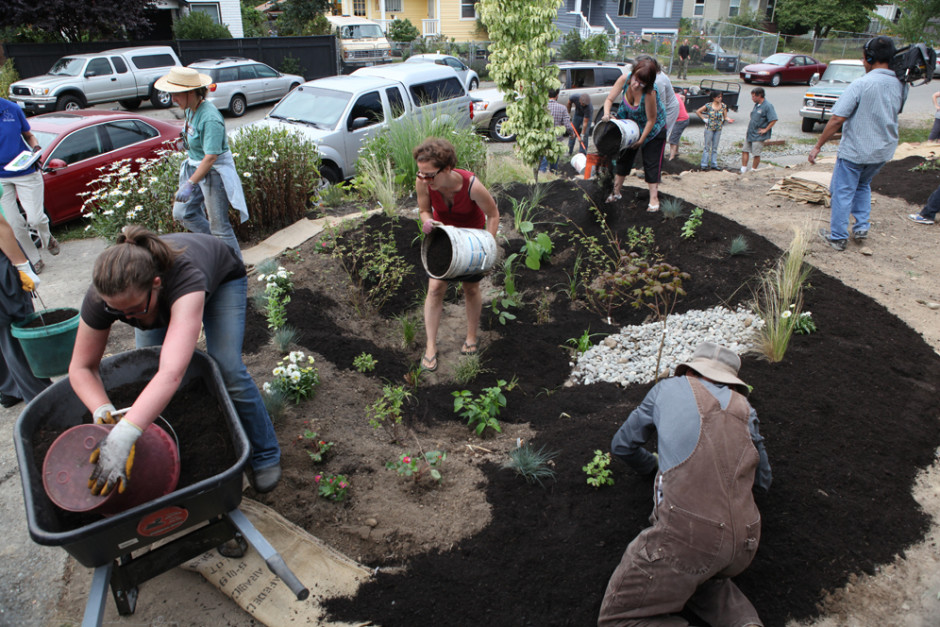
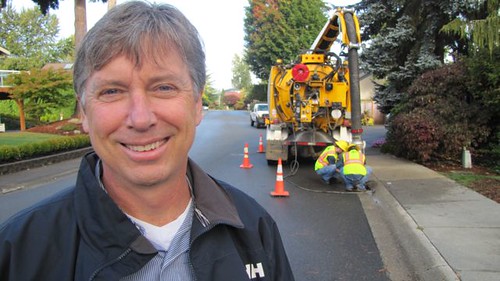


True believers are quick to dismiss the skeptics as either stupid or greedy. I guess that makes it easier to ignore some pretty pertinent questions, such as: if this technology is as easy as they say it is, how did Seattle manage to mess it up so badly in Ballard? The great Ballard “Raingardengue,” as one critic called the mess, was created– not twenty– but two years ago. And it didn’t occur in some tiny unsophisticated burg, but in Seattle. And it wasn’t a small mistake; but it took $500k to undo what they spent about that much constructing. That doesn’t sound to me like they’ve worked out the bugs. Not only that, but no one I’ve spoken to has anyone managed to explain whose responsible for maintenance. If the guy in Issaquah can’t clean out 6000 catch basins once a year, how the heck is he going to get to, say, 20,000 rain gardens–on a monthly or even weekly basis? And if the city doesn’t do the maintenance, does anyone really believe every homeowner is going to be out there weeding and replacing dead plants? Not gonna happen. Or that they’re going to have sufficient numbers of inspectors to catch the homeowner who decides to fill in their rain garden and turn it into a vegetable patch?
Rain garden fans may think these things are cute and simple and all, but what they really are is part of a radical redistribution of what used to be a pretty centralized governmental responsibility. And that’s a lot more complicated than planting a few plants in a ditch–which they haven’t managed to get all the bugs worked out yet. So I’m one of those who’s hoping that someone catches on before the regulations get too far along and bothers to think this through a little more carefully. There are still a lot of unanswered questions; and it would be foolish to go through this whole exercise only to find out a few years down the road we simply traded one fistful of problems for a different fistful.